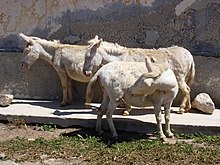|
Asinara donkey
 The Asinara, Italian: Asino dell'Asinara (Italian pronunciation: [ˈaːzino dellaziˈnaːra]), is a breed of feral donkey indigenous to the island of Asinara, which lies off the north-west coast of Sardinia, Italy, in the province of Sassari.[4] Most of the population is wholly or partly albinistic; the small number of grey donkeys on the island are also considered part of the population, and may be heterozygous carriers of the albino gene.[5]: 158 The Asinara is one of the eight autochthonous donkey breeds of limited distribution recognised by the Ministero delle Politiche Agricole Alimentari e Forestali, the Italian ministry of agriculture and forestry.[6]: 18 It is called ainu, borricu or molenti in Sardinian.[7] There are approximately 120 individuals on the island. Others are in the natural reserve of Porto Conte in the comune of Alghero and at the Istituto di Incremento Ippico at Foresta Burgos, and a few are raised in Tuscany and in Emilia Romagna.[5]: 158 HistoryThe Asinara derives from the population of Sardinian donkeys abandoned on the island by the inhabitants when they were forcibly evacuated from it following the passing of the law of 28 June 1885, under which Asinara was to be transformed into a lazaret and penal colony.[5]: 158 White-coated animals had already been seen on the island before this event.[8]: 122 It is also possible that the breed descends from white donkeys imported from Egypt in the nineteenth century by the Duca dell'Asinara.[5]: 158 Like all Italian breeds of donkey, the Asinara is endangered. Its conservation status was listed as "critical" by the FAO in 2007, and was reported to DAD-IS as "critical" in 2021.[1]: 70 [2] A census in 1986 found 31 examples; 59 were counted in 1989, and by the late 1990s the number had reached about 70.[5]: 159 In 2008 there were approximately 120 individuals on the island; others were in the natural reserve of Porto Conte in the comune of Alghero and at the Istituto di Incremento Ippico at Foresta Burgos, and a few were in Tuscany and in Emilia Romagna.[5]: 158 In 2019 the total breed population was 334.[2] It is one of the eight autochthonous donkey breeds of limited distribution recognised by the Ministero delle Politiche Agricole Alimentari e Forestali, the Italian ministry of agriculture and forestry.[6]: 18 CharacteristicsThe Asino dell'Asinara is small, standing no more than 105 cm at the withers. A large proportion of the population is albinistic, with a white coat, unpigmented skin and mucosa, and pinkish-blue eyes.[5]: 159 The eyes are weak, and the animals shelter from strong sunlight in the disused buildings of the former prison on the island.[8]: 121 The hooves are unpigmented and not strong; the gaits are short and uncertain.[5]: 159 The albinism occurs in animals homozygous for a missense mutation in the tyrosinase gene.[8]: 121 The grey donkeys on the island are of about the same size, but are considerably more robust.[5]: 159 They belong to same feral population, the composition of which has not been affected by direct human intervention for over a hundred years.[8]: 120 They can breed freely with the white animals, but are regarded as belonging to the Asino Sardo breed of the island of Sardinia.[5]: 159 [8]: 121 Only white-coated members of the population are registered as Asino dell'Asinara.[6] UseThe donkeys are an integral part of the cultural and environmental heritage of the island of Asinara, which since 2002 has been a national park. Their presence may help to reduce the risk of fire.[5]: 159 ReferencesWikimedia Commons has media related to Asinara donkey.
|
||||||||||||||||||||||||
Portal di Ensiklopedia Dunia
